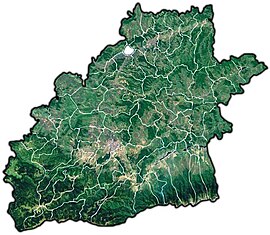Copșa Mică
Copșa Mică | |
|---|---|
 | |
 Location in Sibiu County | |
| Coordinates: 46°6′45″N 24°13′50″E / 46.11250°N 24.23056°E | |
| Country | Romania |
| County | Sibiu |
| Government | |
| • Mayor (2020–2024) | Daniel-Tudor Mihalache[1] (PNL) |
| Area | 25.90 km2 (10.00 sq mi) |
| Elevation | 295 m (968 ft) |
| Population (2021-12-01)[2] | 4,570 |
| • Density | 180/km2 (460/sq mi) |
| Time zone | EET/EEST (UTC+2/+3) |
| Postal code | 555400 |
| Area code | (+40) 02 69 |
| Vehicle reg. | SB |
| Website | www |
Copșa Mică (German: Kleinkopisch; Hungarian: Kiskapus) is a town in Sibiu County, Transylvania, Romania, located north of Sibiu, 33 km east of Blaj, and 12 km southwest of Mediaș. It is on the route of the Via Transilvanica long-distance trail.[3]
Economy[edit]
The Copșa Mică gas field[edit]
The Copșa Mică gas field is a natural gas field located in the town. Discovered in 1915 and developed by Romgaz, it began production in 1920 and produces natural gas and condensates. On July 13, 1933, the biggest fire in the history of Romania occurred at a gas well here, with the flames reaching a height of 150 m (490 ft). The fire was put out by the military after 7 years, and completely extinguished only in 1947.[4]
The Copșa Mică works[edit]
The 1933 fire at the gas field led to the creation of a carbon black factory at Copșa Mică.[4] The town is best known for its status (dating to the 1990s) as one of the most polluted in Europe; in fact, at some point it was the second most polluted after Chernobyl.[5]
This was due to the emissions of two factories in the area:
- One, open from 1935 to 1993, produced carbon black for dyes; its emissions permeated the area for nearly sixty years, leaving soot on homes, trees, animals, and everything else in the area. The stain from these decades of deposits are still visible.
- The other source of the pollution, less visible but with even more serious effects to the health of the town's residents, was Sometra, a smelter whose emissions have contributed to significantly higher incidence of lung disease and impotence, along with a life expectancy nine years below Romania's average.
Demographics[edit]
| Year | Pop. | ±% |
|---|---|---|
| 1966 | 6,156 | — |
| 1977 | 6,194 | +0.6% |
| 1992 | 5,332 | −13.9% |
| 2002 | 5,157 | −3.3% |
| 2011 | 5,201 | +0.9% |
| 2021 | 4,570 | −12.1% |
| Source: Census data | ||
The town's population of 5,201 (as of 2011) is significantly lower compared to its previous level in 1989, the year communism collapsed in Romania. At the 2011 census, 78.8% of inhabitants were Romanians, 11.9% Roma, and 8.7% Hungarians. At the 2021 census, Copșa Mică had a population of 4,570, of which 77.13% were Romanians, 4.81% Hungarians, and 4% Roma.[6]
Administration and local politics[edit]
Town council[edit]
The town's current local council has the following political composition, according to the results of the 2020 Romanian local elections:[7]
| Party | Seats | Current Council | ||||||||
|---|---|---|---|---|---|---|---|---|---|---|
| National Liberal Party (PNL) | 8 | |||||||||
| Save Romania Union (USR) | 3 | |||||||||
| Social Democratic Party (PSD) | 2 | |||||||||
| Democratic Alliance of Hungarians in Romania (UDMR/RMDSZ) | 1 | |||||||||
| Independent politician (Muntean Vasile-Sorin) | 1 | |||||||||
Natives[edit]
- Dan Tăpălagă (born 1975), journalist
References[edit]
- ^ "Results of the 2020 local elections". Central Electoral Bureau. Retrieved 14 June 2021.
- ^ "Populaţia rezidentă după grupa de vârstă, pe județe și municipii, orașe, comune, la 1 decembrie 2021" (XLS). National Institute of Statistics.
- ^ "Terra Saxonum | Via Transilvanica". www.viatransilvanica.com (in Romanian). Retrieved 2023-08-14.
- ^ a b Pal, Cosmin (July 8, 2023). "90 de ani de la cel mai mare incendiu din istoria României. A avut loc la Sonda 5 Copșa Mică, ce exploata gaze naturale" [90 years since the biggest fire in the history of Romania. It took place at Well 5 Copșa Mică, which exploited natural gas]. Sibiu 100 (in Romanian). Retrieved January 28, 2024.
- ^ "Istoria orașului Copșa Mică – al doilea cel mai poluat oraș din Europa, după Cernobîl" [History of the city of Copșa Mică – the second most polluted city in Europe after Chernobyl]. Historia (in Romanian). Retrieved January 28, 2024.
- ^ "Populația rezidentă după grupa de vârstă, pe județe și municipii, orașe, comune, la 1 decembrie 2021" (in Romanian). INSSE. 31 May 2023.
- ^ "Rezultatele finale ale alegerilor locale din 2020" (Json) (in Romanian). Autoritatea Electorală Permanentă. Retrieved 2020-11-02.
External links[edit]
- Town's official website (in Romanian)
- 1993 project funded by UNIDO to assist in the establishment of cleaner production practices at Sometra
- Satellite photos of Copșa Mică in 1986 and 2004 Archived 2012-04-14 at the Wayback Machine
- fragilecologies.com: The People and Pollution of Copșa Mică, Romania
- Copșa Mică's Past and Future: Can Europe's Most Polluted Town Go Green?



